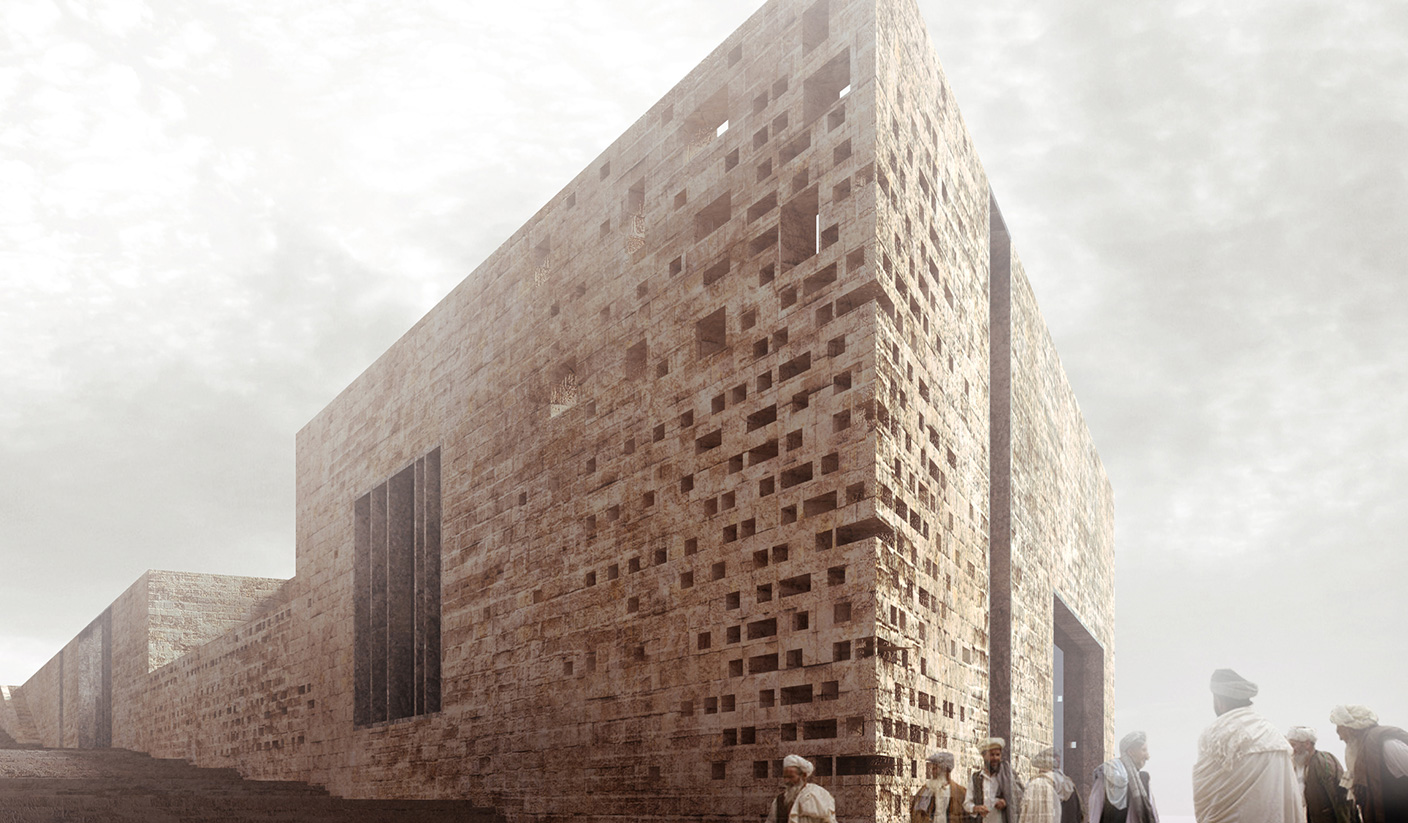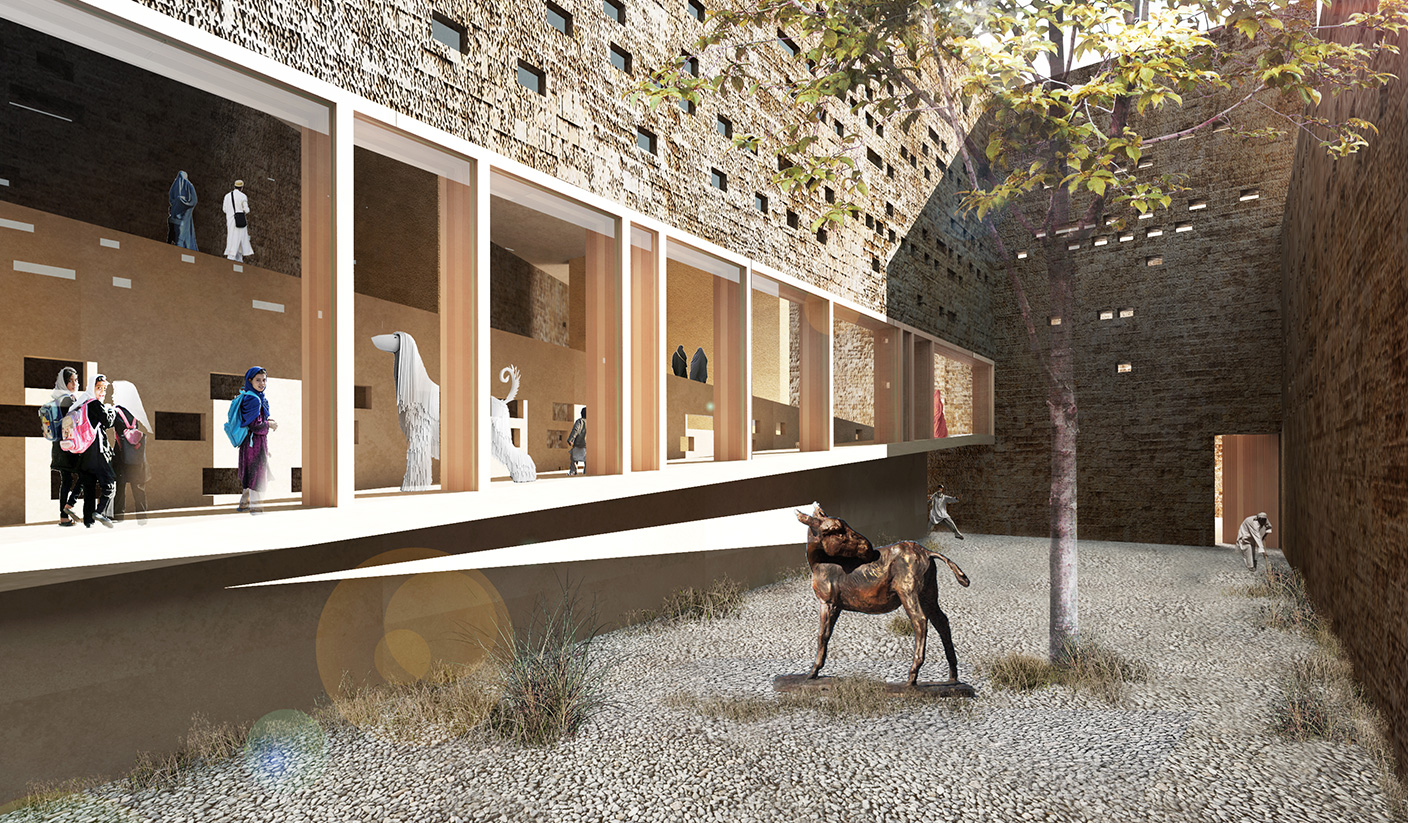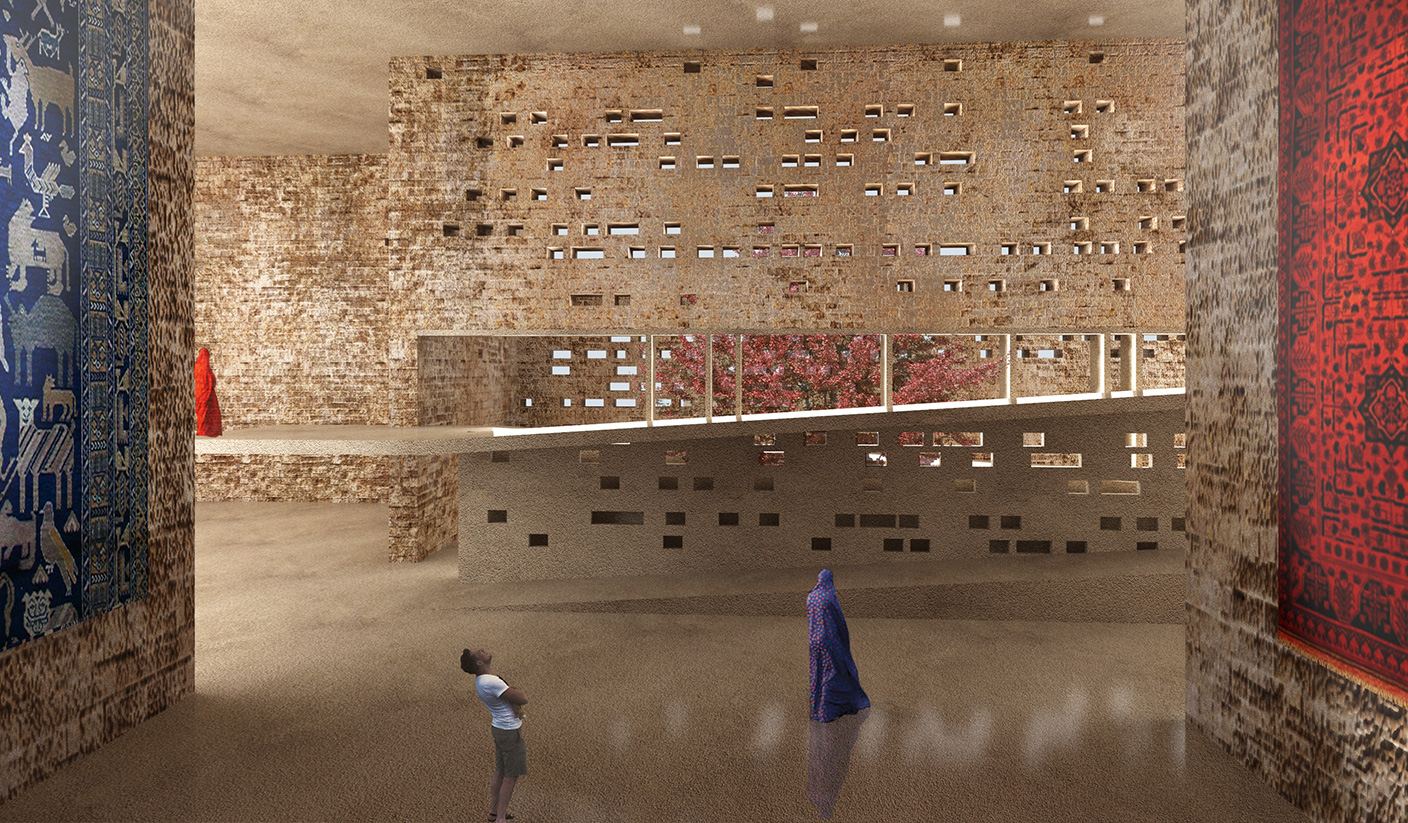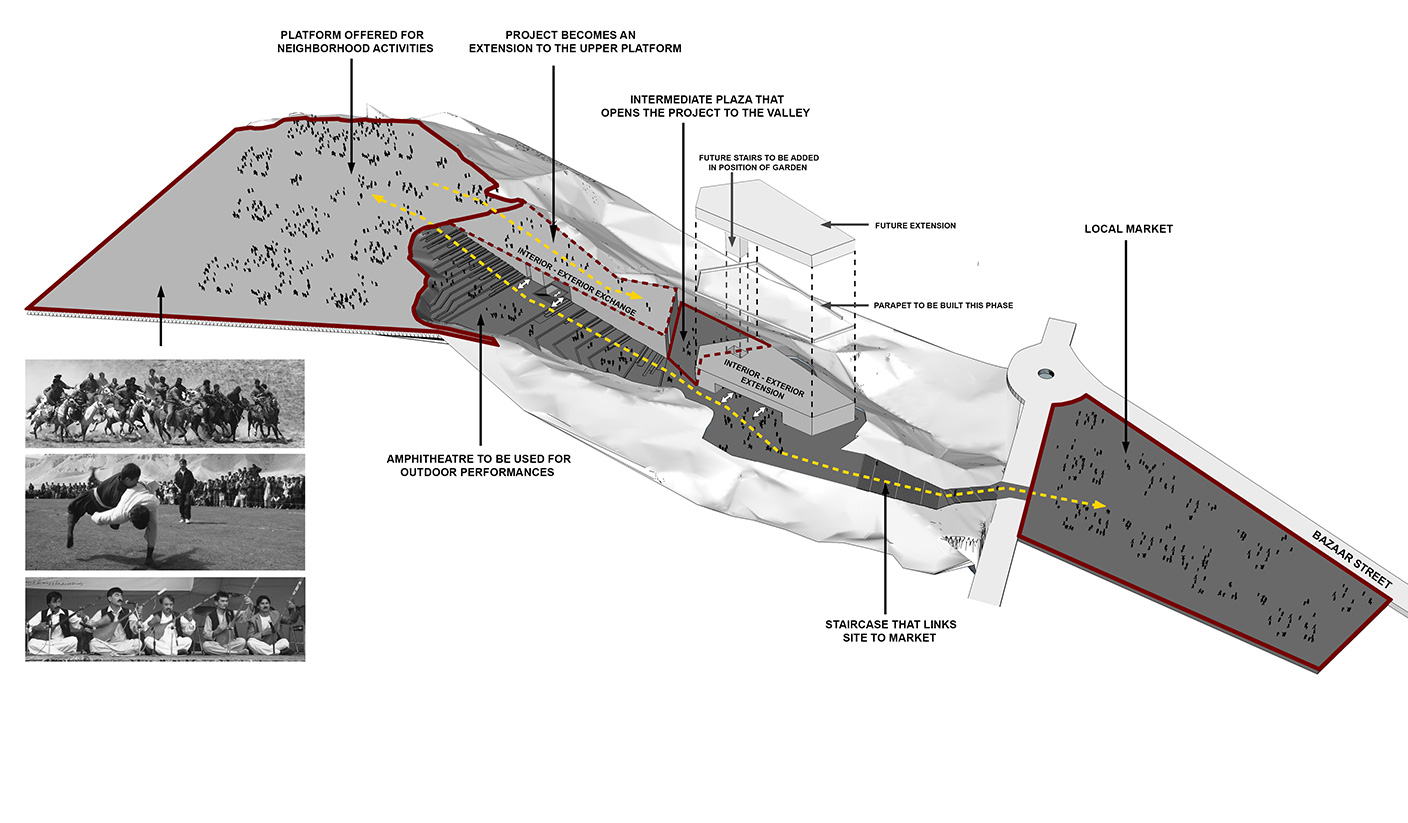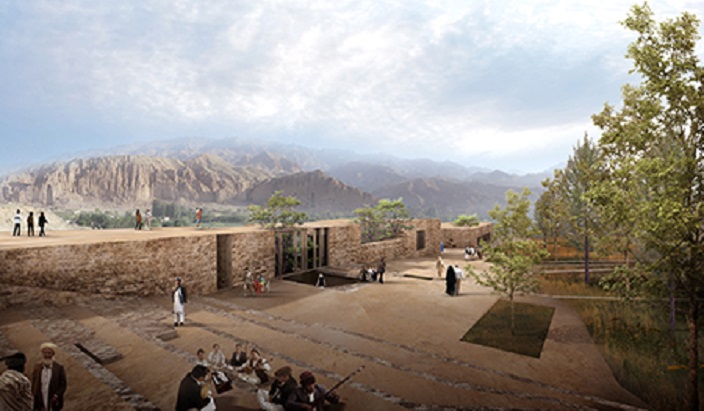Fact Sheet
- Project: Bamiyan Cultural Center
- Category: Public
- Location: Bamiyan, Afghanistan
- Client: Unesco
- Built-up area: 2,200 sqm
- Budget: N/A
- Year: 2015
- Status: Competition Entry
Credits
- Partner in Charge: Ibrahim Berberi
- Architect in Charge: Samer Bazzi
- Team: Kim Akiki, Richard Kassab, Joy Traboulsi, Albert Karam, Nadine Harake
Collaborators
- Renders: Tony Antoun
Presence in Absence
Perched high above the city, the site creates the setting of an expansive platform offering sweeping views of the Bamiyan. Located on a panoramic plateau and acting as a 360 degrees panopticon, the site celebrates its central location: The site overlooks and absorbs the visual and spatial flows of its surroundings.
As clearly viewed from the site, large niches where statues of Buddahs once stood facing the Bamiyan city are carved into the sides of cliffs. These prominent imprints represent the previous existence of the missing Buddahs and their historical symbolism. Staring out like an empty eye, and now void of Buddahs, there is a strong sensation of something missing – the absent.
A similar feeling is experienced on the site - repeatedly disfigured by man’s presence, the site is reminiscent of its destructions. Expressing feeling of absence and emptiness, the incompleteness of the site is a peculiarity and uniqueness that the proposal highlights and addresses to preserve.
Amidst the Bamiyan’s strong identity and rural setting, the site stands distinctly elevated in the vicinity of a hilly terrain. The proposal expresses historical and cultural identity through an urban element capable of enhancing these rural characteristics.
The site’s challenge lies in the ability to form a prominent and attractive design while remaining responsive and non-invasive. The project aims to minimize its presence by becoming as natural to its surroundings as possible. The new development references the original topography and materiality of the mountain by using the local materials. The use of local and accessible materials blends with the landscape, the village and the people. The proposal is a symbiotic blend of a contextually sensitive scheme addressing the rural character of the neighborhood and a bold intervention that announces its presence atop the silk road of the Bamiyan.
At first glance the community center appears to be audaciously sited atop a glacial hill. However, the 2,220 sqm development merges with the hill and recreates the previously destructed mountain. The unique sensation of the platform is a quality the design focuses on to highlight and keep. Prolonging the platform, the proposal provides a recovered highland which better suits the needs of the center to overlook and absorb its entire environment.
Untouched, the large upper platform remains accessible to the greater public at all times. On the inner side of the proposal, an outdoor amphitheater continues this space and takes advantage of the existing topographic conditions. The program’s public activities are strategically located along this edge, blurring the lines between inside and outside and engaging visitors with a sequence of interconnected interior and exterior spaces. Providing two independent event spaces to be used for performances and workshops, the design allows for an increased number of visitors and encourages social interaction.
As clearly viewed from the site, large niches where statues of Buddahs once stood facing the Bamiyan city are carved into the sides of cliffs. These prominent imprints represent the previous existence of the missing Buddahs and their historical symbolism. Staring out like an empty eye, and now void of Buddahs, there is a strong sensation of something missing – the absent.
A similar feeling is experienced on the site - repeatedly disfigured by man’s presence, the site is reminiscent of its destructions. Expressing feeling of absence and emptiness, the incompleteness of the site is a peculiarity and uniqueness that the proposal highlights and addresses to preserve.
Amidst the Bamiyan’s strong identity and rural setting, the site stands distinctly elevated in the vicinity of a hilly terrain. The proposal expresses historical and cultural identity through an urban element capable of enhancing these rural characteristics.
The site’s challenge lies in the ability to form a prominent and attractive design while remaining responsive and non-invasive. The project aims to minimize its presence by becoming as natural to its surroundings as possible. The new development references the original topography and materiality of the mountain by using the local materials. The use of local and accessible materials blends with the landscape, the village and the people. The proposal is a symbiotic blend of a contextually sensitive scheme addressing the rural character of the neighborhood and a bold intervention that announces its presence atop the silk road of the Bamiyan.
At first glance the community center appears to be audaciously sited atop a glacial hill. However, the 2,220 sqm development merges with the hill and recreates the previously destructed mountain. The unique sensation of the platform is a quality the design focuses on to highlight and keep. Prolonging the platform, the proposal provides a recovered highland which better suits the needs of the center to overlook and absorb its entire environment.
Untouched, the large upper platform remains accessible to the greater public at all times. On the inner side of the proposal, an outdoor amphitheater continues this space and takes advantage of the existing topographic conditions. The program’s public activities are strategically located along this edge, blurring the lines between inside and outside and engaging visitors with a sequence of interconnected interior and exterior spaces. Providing two independent event spaces to be used for performances and workshops, the design allows for an increased number of visitors and encourages social interaction.

